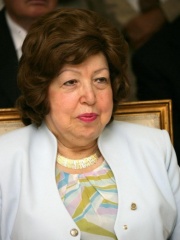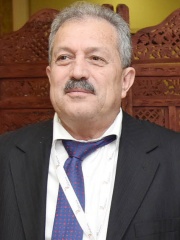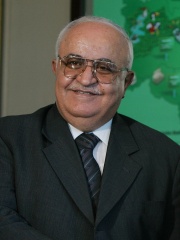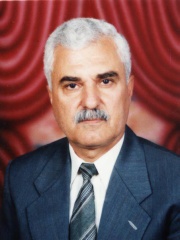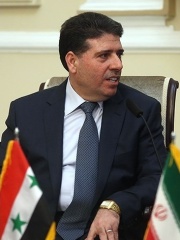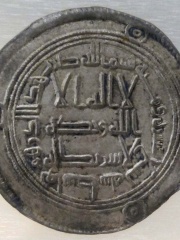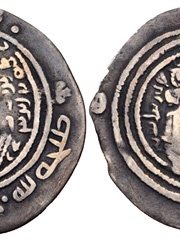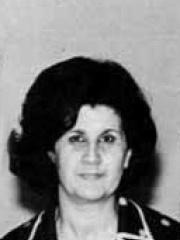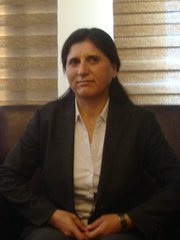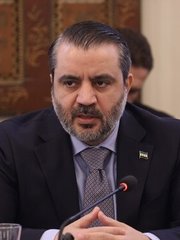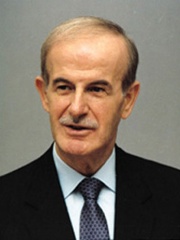


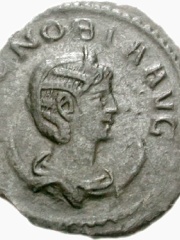
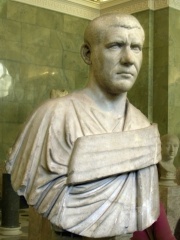
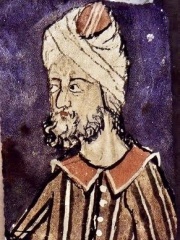

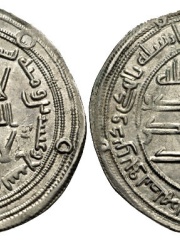
The Most Famous
POLITICIANS from Syria
This page contains a list of the greatest Syrian Politicians. The pantheon dataset contains 19,576 Politicians, 101 of which were born in Syria. This makes Syria the birth place of the 39th most number of Politicians behind Canada, and Serbia.
Top 10
The following people are considered by Pantheon to be the top 10 most legendary Syrian Politicians of all time. This list of famous Syrian Politicians is sorted by HPI (Historical Popularity Index), a metric that aggregates information on a biography's online popularity. Visit the rankings page to view the entire list of Syrian Politicians.

1. Hafez al-Assad (1930 - 2000)
With an HPI of 87.19, Hafez al-Assad is the most famous Syrian Politician. His biography has been translated into 85 different languages on wikipedia.
Hafez al-Assad (6 October 1930 – 10 June 2000) was a Syrian politician and military officer who served as the president of Syria from 1971 until his death in 2000. He was previously the prime minister from 1970 to 1971 as well as the regional secretary of the regional command of the Syrian regional branch of the Arab Socialist Ba'ath Party and secretary general of the National Command of the Ba'ath Party from 1970 to 2000. Assad was a key participant in the 1963 Syrian coup d'état, which brought the Syrian regional branch of the Arab Socialist Ba'ath Party to power in the country, a power that lasted until the fall of the regime in 2024, then led by his son Bashar. After the 1963 coup, the new leadership appointed Assad as the commander of the Syrian Arab Air Force. In February 1966 Assad participated in a second coup, which toppled the traditional leaders of the Ba'ath Party. Assad was appointed defense minister by the new government. Four years later Assad initiated a third coup, which ousted the Marxist regime of Salah Jadid, and appointed himself as leader of Syria. Assad imposed various changes to the Ba'athist foreign policy after seizing power, such as abandoning Salah Jadid's policy of exporting "socialist revolution" and strengthening Syria's foreign relations with countries that his predecessor had deemed "reactionary". Assad made an alliance with the Soviet Union and the Eastern Bloc during the Cold War in return for support against Israel, while keeping ties with many Western European & Gulf Arabian countries. While he officially kept the pan-Arab concept of unifying the Arab world into one “Arab nation” as he termed it, such as being part of the Federation of Arab Republics, he sought to paint Syria as the defender of the Palestinians against Israel. Assad quickly consolidated his power. Right after Gamal Abdel Nasser's death, he sought to reconciliate Syria with the other Arab countries, which have been harmed under Jadid’s rule. He also tried to form new ties with countries from both camps in the Cold War. As a result, he got economic support from OPEC members during the Oil embargo, as a show of support to his war against Israel in 1973, the October War. While Syria remained a one-party system, Ba'athist decision-making authority that had previously been collegial was reduced in favour of empowering the president’s absolute control over the country. To maintain his personalistic rule, a cult of personality centred on Assad and his family was created by the president and the Ba'ath party. Assad ordered an Arabization campaign on Kurdish areas of Syria and started intervention in Lebanon in 1976, which resulted in the Syrian occupation of Lebanon. During his rule, his regime crushed an Islamist uprising led by the Syrian Muslim Brotherhood rebels through a series of crackdowns culminating in the Hama massacre, which led to two thirds of the city of Hama being destroyed. His regime was accused of numerous human rights violations, including opening prison death camps. Assad's initial preferred successor as president was his brother Rifaat, but Rifaat attempted to seize power in 1983–1984 when Hafez had a health scare and he was subsequently exiled. Assad's next choice of successor was his eldest son, Bassel. However, Bassel died in a high-speed car crash in 1994, and Assad turned to his third choice—his younger son Bashar, who at that time was a medical student in the UK, with no political experience. The move to appoint a member of his own family as his successor was met with criticism in some quarters of the Syrian ruling class, but Assad persisted with his plan and demoted officials who opposed this succession. Assad died in June 2000 and Bashar succeeded him as president, serving until his overthrow in December 2024.

2. Bashar al-Assad (b. 1965)
With an HPI of 82.22, Bashar al-Assad is the 2nd most famous Syrian Politician. His biography has been translated into 119 different languages.
Bashar al-Assad (born 11 September 1965) is a Syrian former politician, doctor and military officer who served as the president of Syria from 2000 until his overthrow in 2024 after the Syrian civil war. As president, Assad was commander-in-chief of the Syrian Arab Armed Forces and secretary-general of the Central Command of the Arab Socialist Ba'ath Party. He is the son of Hafez al-Assad, who ruled Syria from 1970 to 2000. In the 1980s, Assad became a doctor, and in the early 1990s he was training in London as an ophthalmologist. In 1994, after his elder brother Bassel al-Assad died in a car crash, Assad was recalled to Syria to take over Bassel's role as heir apparent. Assad entered the military academy and in 1998 took charge of the Syrian occupation of Lebanon begun by his father. On 17 July 2000, Assad became president, succeeding his father, who had died on 10 June 2000. Hopes that the UK-educated Assad would bring reform to Syria and relax the occupation of Lebanon were dashed following a series of crackdowns in 2001–2002 that ended the Damascus Spring, a period defined by calls for transparency and democracy. Assad's rule would become more repressive than his father's. Assad's first decade in power was marked by extensive censorship, summary executions, forced disappearances, discrimination against ethnic minorities, and extensive surveillance by the Ba'athist secret police. While the Assad government described itself as secular, various political scientists and observers noted that his regime exploited sectarian tensions in the country. Although Assad inherited Hafez's power structures and personality cult, he lacked the loyalty received by his father and faced rising discontent against his rule. As a result, many people from his father's regime resigned or were purged, and the political inner circle was replaced by staunch loyalists from Alawite clans. Assad's early economic liberalisation programs worsened inequalities and centralised the socio-political power of the loyalist Damascene elite of the Assad family, alienating the Syrian rural population, urban working classes, businessmen, industrialists, and people from traditional Ba'ath strongholds. Assad was forced to end the Syrian occupation of Lebanon during the Cedar Revolution in 2005, which was triggered by the assassination of Lebanese prime minister Rafic Hariri. The Mehlis report implicated Assad's regime in the assassination, with a particular focus on Maher al-Assad, Assef Shawkat, Hassan Khalil, Bahjat Suleiman, and Jamil Al Sayyed. After the Syrian revolution began in 2011, Assad led a deadly crackdown against Arab Spring protests which led to outbreak of the Syrian civil war. The Syrian opposition, United States, European Union, and the majority of the Arab League called on him to resign, but he refused and the war escalated. Between 2011 and 2024, over 600,000 people were killed, with pro-Assad forces causing more than 90% of civilian casualties. Throughout the war, the Ba'athist Syrian armed forces carried out several chemical attacks. In 2013, the United Nations (UN) High Commissioner for Human Rights stated that findings from a UN inquiry directly implicated Assad in crimes against humanity. The regime's perpetration of war crimes led to international condemnation and isolation, although Assad maintained power with assistance from Syria's longtime allies Iran and Russia. Iran launched a military intervention in support of his government in 2013 and Russia followed in 2015; by 2021, Assad's regime had regained control over most of the country. In November 2024, a coalition of Syrian rebels mounted several offensives with the intention of ousting Assad. On the morning of 8 December, as rebel troops first entered Damascus, Assad fled to Moscow and was granted political asylum by the Russian government. Later that day, Damascus fell to rebel forces, and Assad's regime collapsed. Assad's regime was a highly personalist dictatorship that governed Syria as a totalitarian police state. It committed systemic human rights violations and war crimes, making it one of the most repressive regimes in modern times. The regime was consistently ranked among the "worst of the worst" within Freedom House indexes. In 2025, France issued three arrest warrants against Assad in connection with the bombing of a civilian-populated area in Daraa in 2017 that killed Franco-Syrian dual national Salah Abou Nabout, the 2012 killings of journalists Marie Colvin and Remi Ochlik in Homs, and the Ghouta chemical attacks in 2013. In September 2025, a Syrian court issued an arrest warrant for Assad over the killing of civilians during the Siege of Daraa in 2011, paving the way for its circulation through Interpol. The arrest warrant cited charges such as "premeditated murder", "torture leading to death", and "deprivation of liberty".

3. Elagabalus (203 - 222)
With an HPI of 81.84, Elagabalus is the 3rd most famous Syrian Politician. His biography has been translated into 79 different languages.
Marcus Aurelius Antoninus (born Sextus Varius Avitus Bassianus, c. 204 – 13 March 222), better known by his posthumous nicknames Elagabalus ( EL-ə-GAB-ə-ləs) and Heliogabalus ( HEE-lee-ə-, -lee-oh-), was Roman emperor from 218 to 222, while he was still a teenager. His short reign was notorious for religious controversy and alleged sexual debauchery. A close relative to the Severan dynasty, he came from a prominent Syrian Arab family in Emesa (Homs), Syria, where he served as the head priest of the sun god Elagabal from a young age. After the death of his cousin, the emperor Caracalla, Elagabalus was raised to the Principate at 14 years of age in an army revolt instigated by his grandmother Julia Maesa against Caracalla's short-lived successor, Macrinus. He only posthumously became known by the Latinised name of his god. Elagabalus is largely known from accounts by the contemporary senator Cassius Dio who was hostile to him, Herodian, who likely relied extensively on Dio, and the much later Historia Augusta. The reliability of the accounts of Cassius Dio and the Historia Augusta, particularly their most salacious elements, has been questioned. Elagabalus showed a disregard for Roman religious traditions. He brought the cult of Elagabal (including the large baetyl stone that represented the god) to Rome, making it a prominent part of religious life in the city. He forced leading members of Rome's government to participate in religious rites celebrating this deity, presiding over them in person. According to the accounts of Cassius Dio and the Augusta, he married four women, including a Vestal Virgin, in addition to lavishing favours on male courtiers they suggested to have been his lovers, and prostituted himself. His behaviour estranged the Praetorian Guard, the Senate, and the common people alike. Amidst growing opposition, at just 18 years of age he was assassinated and replaced by his cousin Severus Alexander in March 222. The assassination plot against Elagabalus was devised by Julia Maesa and carried out by disaffected members of the Praetorian Guard. Elagabalus developed a posthumous reputation for extreme eccentricity, decadence, zealotry, and sexual promiscuity. Among writers of the early modern age, he endured one of the worst reputations among Roman emperors. Edward Gibbon, notably, wrote that Elagabalus "abandoned himself to the grossest pleasures with ungoverned fury". According to Barthold Georg Niebuhr, "the name of Elagabalus is branded in history above all others; [...] "Elagabalus had nothing at all to make up for his vices, which are of such a kind that it is too disgusting even to allude to them". An example of a modern historian's assessment is Adrian Goldsworthy's: "Elagabalus was not a tyrant, but he was an incompetent, probably the least able emperor Rome had ever had". Despite near-universal condemnation of his reign, some scholars write warmly about his religious innovations, including the 6th-century Byzantine chronicler John Malalas, as well as Warwick Ball, a modern historian who described him as "a tragic enigma lost behind centuries of prejudice". Modern scholars have questioned the accuracy of Roman accounts of his reign, with suggestions that the reports of his salacious behaviour and sexual excess likely reflected a desire to politically discredit him in the immediate aftermath of his death, as well as reflecting Roman stereotypes regarding people from the Orient as effeminate.

4. Zenobia (240 - 275)
With an HPI of 78.70, Zenobia is the 4th most famous Syrian Politician. Her biography has been translated into 58 different languages.
Septimia Zenobia (Palmyrene Aramaic: 𐡡𐡶𐡦𐡡𐡩, romanized: Bat-Zabbai; c. 240 – c. 274) was a third-century queen of the Palmyrene Empire in Syria. Many legends surround her ancestry; she was probably not a commoner, and she married Odaenathus, the ruler of the city of Palmyra. Her husband became king of Palmyra in 260, elevating Palmyra to supreme power in the Near East by defeating the Sasanian Empire of Persia and stabilizing the Roman East. After Odaenathus' assassination in 267, Zenobia became the regent of her son Vaballathus and held de facto power throughout his reign (267 to 272). In 270, Zenobia launched an invasion that brought most of the Roman East under her sway and culminated with the annexation of Egypt. By mid-271 her realm extended from Ancyra, central Anatolia, to Upper Egypt, although she remained nominally subordinate to Rome. However, in reaction to the campaign of the Roman emperor Aurelian in 272, Zenobia declared her son emperor and assumed the title of empress, thus declaring Palmyra's secession from Rome. The Romans were victorious after heavy fighting; the empress was besieged in her capital and captured in late 272 by Aurelian, who exiled her to Rome, where she spent the remainder of her life. Zenobia was a cultured monarch and fostered an intellectual environment in her court, which was open to scholars and philosophers. She was tolerant toward her subjects and protected religious minorities. The empress maintained a stable administration, which governed a multicultural, multiethnic empire. Zenobia died after 274, and many tales have been recorded about her fate. Her rise and fall have inspired historians, artists and novelists, and she is a patriotic symbol in Syria.

5. Yazid I (647 - 683)
With an HPI of 78.57, Yazid I is the 5th most famous Syrian Politician. His biography has been translated into 59 different languages.
Yazid ibn Mu'awiya ibn Abi Sufyan (c. 646 – 11 November 683), commonly known as Yazid I, was the second caliph of the Umayyad Caliphate, ruling from April 680 until his death in November 683. His appointment by his father Mu'awiya I (r. 661–680) was the first hereditary succession to the caliphate in Islamic history. His caliphate was marked by the death of Muhammad's grandson Husayn ibn Ali and the start of the crisis known as the Second Fitna. During his father's caliphate, Yazid led several campaigns against the Byzantine Empire including an attack on the Byzantine capital, Constantinople. Yazid's nomination as heir apparent in 676 CE (56 AH) by Mu'awiya was opposed by several Muslim grandees from the Hejaz region, including Husayn and Abd Allah ibn al-Zubayr. The two men refused to recognize Yazid following his accession and took sanctuary in Mecca. When Husayn left for Kufa in Iraq to lead a revolt against Yazid, he was killed with his small band of supporters by Yazid's forces in the Battle of Karbala. Husayn's death caused resentment in the Hejaz, where Ibn al-Zubayr called for a consultative assembly to elect a new caliph. The people of Medina, who supported Ibn al-Zubayr, held other grievances toward the Umayyads. After failing to gain the allegiance of Ibn al-Zubayr and the people of the Hejaz through diplomacy, Yazid sent an army to suppress their rebellion. The army defeated the Medinans in the Battle of al-Harra in August 683 and the city was plundered. Afterward, Mecca was besieged for several weeks until the army withdrew as a result of Yazid's death in November 683. The Caliphate fell into a nearly decade-long civil war, ending with the establishment of the Marwanid dynasty (the Umayyad caliph Marwan I and his descendants). Yazid continued Mu'awiya's decentralized model of governance, relying on his provincial governors and the tribal nobility. He abandoned Mu'awiya's ambitious raids against the Byzantine Empire and strengthened Syria's military defenses. No new territories were conquered during his reign. Yazid is considered an illegitimate ruler and a tyrant by many Muslims due to his hereditary succession, the death of Husayn, and his attack on Medina. Modern historians take a milder view, and consider him a capable ruler, albeit less successful than his father.

6. Philip the Arab (204 - 249)
With an HPI of 77.17, Philip the Arab is the 6th most famous Syrian Politician. His biography has been translated into 73 different languages.
Philip I (Latin: Marcus Julius Philippus; c. 204 – September 249), commonly known as Philip the Arab, was Roman emperor from 244 to 249. After the death of Gordian III in February 244, Philip, who had been Praetorian prefect, rose to power. He quickly negotiated peace with the Sasanian Empire and returned to Rome to be confirmed by the Senate. Although his reign lasted only five years, it marked an unusually stable period in a century that is otherwise known for having been turbulent. Near the end of his rule, Philip commemorated Rome's first millennium. In September 249 he was killed during or shortly after the Battle of Verona against the usurper Trajan Decius, who was subsequently recognized by the Senate as his successor. Born in modern-day Shahba, Syria, in what was then Arabia Petraea, Philip's ethnicity was most likely Arab. While he publicly adhered to the Roman religion, he was later asserted to have been a Christian, and in the later half of the 3rd century and into the beginning of the 4th century, some Christian clergymen held that Philip had been Christian. He was described as such in many published works that became widely known during the Middle Ages, including: Chronicon (lit. 'Chronicle'); Historiae Adversus Paganos (lit. 'History Against the Pagans'); and Historia Ecclesiastica (lit. 'Ecclesiastical History'). Consequently, Philip's religious affiliation remains a divisive topic in modern scholarly debate about his life.

7. Imad ad-Din Zengi (1087 - 1146)
With an HPI of 76.37, Imad ad-Din Zengi is the 7th most famous Syrian Politician. His biography has been translated into 48 different languages.
Imad al-Din Zengi (Arabic: عماد الدین زنكي; c. 1084/88 – 14 September 1146), also romanized as Zangi, Zengui, Zenki, and Zanki, was a Turkoman atabeg of the Seljuk Empire, who ruled Mosul, Aleppo, Hama, and, later, Edessa. He was the namesake and founder of the Zengid dynasty of atabegs.

8. Abd al-Rahman I (731 - 788)
With an HPI of 74.67, Abd al-Rahman I is the 8th most famous Syrian Politician. His biography has been translated into 57 different languages.
Abd al-Rahman ibn Mu'awiya ibn Hisham ibn Abd al-Malik ibn Marwan ibn Abi al-'As ibn Umayya ibn Abd Shams al-Marwani al-Umawi al-Qurashi (Arabic: عبد الرحمن إبن معاوية إبن هشام, romanized: ʿAbd al-Raḥmān ibn Muʿāwiya ibn Hishām; 7 March 731 – 30 September 788), commonly known as Abd al-Rahman I, was the founder and first emir of the Emirate of Córdoba, ruling from 756 to 788. He established the Umayyad dynasty in al-Andalus, which continued for nearly three centuries (including the succeeding Caliphate of Córdoba). Abd al-Rahman was a member of the Umayyad dynasty in Damascus, and his establishment of a government in Iberia represented a break with the Abbasids, who had overthrown the Umayyads in Damascus in 750. He was also known by the surnames al-Dakhil ("the Immigrant"), Saqr Quraysh ("the Falcon of Quraysh").

9. Marwan II (688 - 750)
With an HPI of 73.46, Marwan II is the 9th most famous Syrian Politician. His biography has been translated into 45 different languages.
Marwan ibn Muhammad ibn Marwan (Arabic: مروان بن محمد بن مروان, romanized: Marwān ibn Muḥammad ibn Marwān; c. 691– 6 August 750), commonly known as Marwan II and surnamed al-Himar (Arabic: الحمار), was the fourteenth and last caliph of the Umayyad Caliphate, ruling from 744 until his death. His reign was dominated by a civil war, and he was the last Umayyad ruler to rule the united Caliphate before the Abbasid Revolution toppled the Umayyad dynasty.
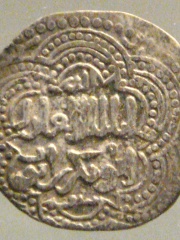
10. Al-Adil I (1145 - 1218)
With an HPI of 72.75, Al-Adil I is the 10th most famous Syrian Politician. His biography has been translated into 33 different languages.
Al-Adil I (Arabic: العادل, in full al-Malik al-Adil Sayf ad-Din Abu-Bakr Ahmed ibn Najm ad-Din Ayyub, Arabic: الملك العادل سيف الدين أبو بكر بن أيوب, "Ahmed, son of Najm ad-Din Ayyub, father of Bakr, the Just King, Sword of the Faith"; 1145 – 31 August 1218) was the fourth Sultan of Egypt and Syria, and brother of Saladin, who founded both the Sultanate of Egypt, and the Ayyubid dynasty. He was known to the Crusaders as Saphadin (derived from his laqab or honorific title Sayf ad-Din, meaning "Sword of Faith"), a name by which he is still known in the Western world. A gifted and effective administrator and organizer, Al-Adil provided crucial military and civilian support for the great campaigns of Saladin (an early example of a great minister of war). He was also a capable general and strategist in his own right, and was instrumental in the transformation of the decayed Fatimid Caliphate of Cairo into the Ayyubid Sultanate of Egypt.
People
Pantheon has 101 people classified as Syrian politicians born between 1850 BC and 2009. Of these 101, 28 (27.72%) of them are still alive today. The most famous living Syrian politicians include Bashar al-Assad, Levon Ter-Petrosyan, and Najah al-Attar. The most famous deceased Syrian politicians include Hafez al-Assad, Elagabalus, and Zenobia. As of April 2024, 7 new Syrian politicians have been added to Pantheon including Mohammed al-Bashir, Mohammad Ghazi al-Jalali, and Rima Hassan.
Living Syrian Politicians
Go to all RankingsBashar al-Assad
1965 - Present
HPI: 82.22
Levon Ter-Petrosyan
1945 - Present
HPI: 68.95
Najah al-Attar
1933 - Present
HPI: 65.08
Bushra al-Assad
1960 - Present
HPI: 64.77
Hussein Arnous
1953 - Present
HPI: 64.42
Muhammad Naji al-Otari
1944 - Present
HPI: 63.82
Salih Muslim
1951 - Present
HPI: 62.60
Ali Abdullah Ayyoub
1952 - Present
HPI: 61.42
George Sabra
1947 - Present
HPI: 60.99
Salim Idris
1957 - Present
HPI: 59.73
Adel Safar
1953 - Present
HPI: 58.85
Wael Nader al-Halqi
1964 - Present
HPI: 58.16
Deceased Syrian Politicians
Go to all RankingsHafez al-Assad
1930 - 2000
HPI: 87.19
Elagabalus
203 - 222
HPI: 81.84
Zenobia
240 - 275
HPI: 78.70
Yazid I
647 - 683
HPI: 78.57
Philip the Arab
204 - 249
HPI: 77.17
Imad ad-Din Zengi
1087 - 1146
HPI: 76.37
Abd al-Rahman I
731 - 788
HPI: 74.67
Marwan II
688 - 750
HPI: 73.46
Al-Adil I
1145 - 1218
HPI: 72.75
Hisham ibn Abd al-Malik
691 - 743
HPI: 72.60
Muawiya II
661 - 684
HPI: 72.53
Anisa Makhlouf
1930 - 2016
HPI: 72.20
Newly Added Syrian Politicians (2025)
Go to all RankingsMohammed al-Bashir
HPI: 55.64
Mohammad Ghazi al-Jalali
1969 - Present
HPI: 54.55
Rima Hassan
1992 - Present
HPI: 46.99
Asya Abdullah
1971 - Present
HPI: 43.81
Asaad al-Shaibani
HPI: 43.51
Amna Suleiman
HPI: 36.92
Muzoon Almellehan
1999 - Present
HPI: 34.40
Overlapping Lives
Which Politicians were alive at the same time? This visualization shows the lifespans of the 25 most globally memorable Politicians since 1700.


